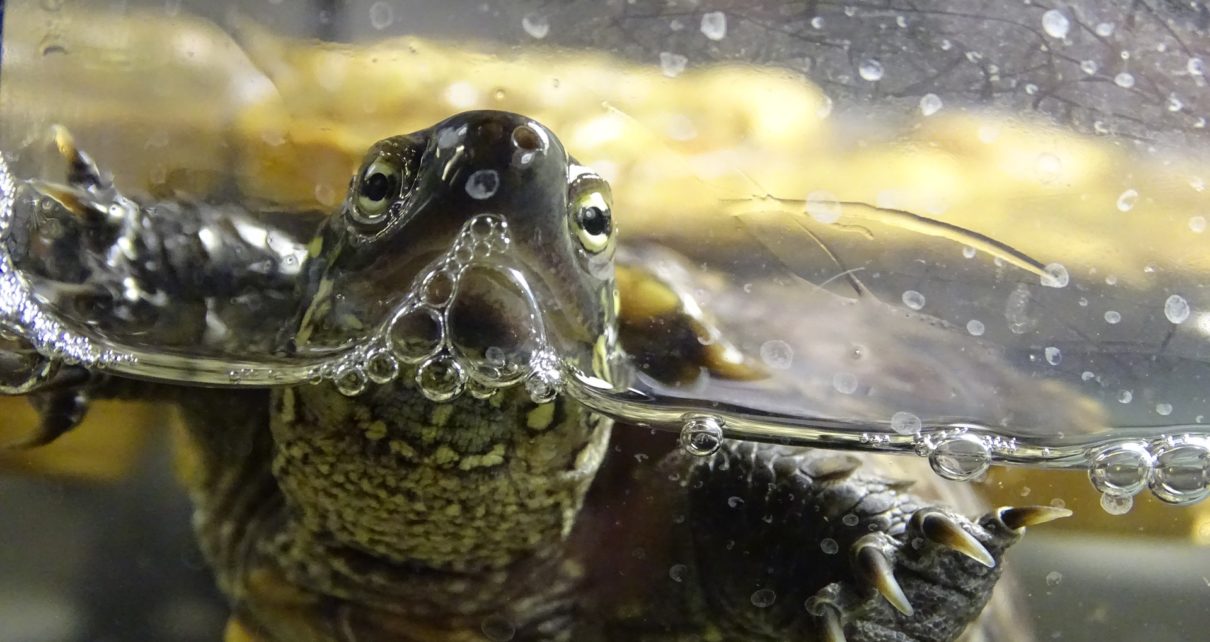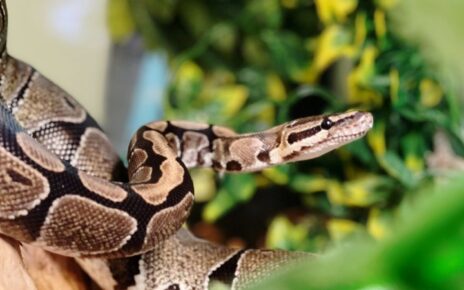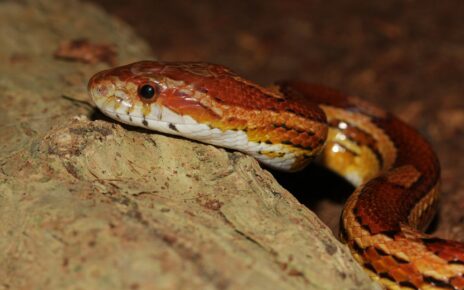Turtles are a fun and interesting pet for people of all ages. They can be very active, and they love swimming around all day with their tank mates. Since they spend most of their time in the water, they need a filter that can keep their tank free of debris and other harmful waste byproducts. So, what is the best canister filter for turtles?
We recommend the Zoo Med 511 Turtle Clean Canister Filter (Buy Online) for tanks under 55 gallons, and the Fluval FX6 Canister Filter (Buy Online) for larger turtle tank setups.
Best Canister Filter for Turtles
Zoo Med 511 Turtle Clean Canister Filter
The Zoo Med 511 Turtle Clean Canister Filter (Buy Online) is one of the best canister filters for a turtle tank on the market. This filter is specifically designed to process the high biological load found in most turtle tanks. The Zoo Med 511 can handle tanks up to 60 gallons, and it has a flow rate of 160 GPH (gallons per hour).
Zoo Med Turtle Clean filters use a 3-stage filtration process to keep your turtle tank free of debris and toxins. The first stage in this filter removes any floating particles and bits of uneaten food from the water. This filter stage is made up of a sponge that can be reused multiple times by simply rinsing it off in some dechlorinated water.
The second stage in this filter provides chemical filtration. This stage uses activated carbon to remove dissolved organic waste from the water. These activated carbon pouches are the only thing in this filter that isn’t reusable. That means you will have to change out the carbon pouches during normal filter maintenance.
Biological filtration is the third and final stage in this filter. The Zoo Med Turtle Clean uses ceramic bio-media to break down ammonia into less toxic compounds. The ceramic biological media has a very high surface area, so it can house a large number of nitrifying bacteria. That allows it to process more waste in a smaller volume versus other forms of biological filtration. The ceramic media is also reusable since it won’t degrade over time, and if it does get clogged all you will need to do is rinse it.
The Zoo Med Turtle Clean line of filters comes in a wide range of sizes and flow rates, so if you have a larger tank you can choose from one of those options. The next model size up is the Zoo Med TC75, this filter can handle tanks up to 75 gallons and it has a flow rate of 265 GPH.
All the Zoo Med Turtle Clean filters come with a spray bar which will release water back into the tank over a more distributed area. This will help oxygenate the tank, and it can help prevent dead spots from forming in the water. Zoo Med Turtle Clean filters come complete with all the hoses, clips and suction cups you will need to easily install this filter, so it is ready to go right out of the box once it arrives at your doorstep.
Fluval Canister Filter
The Fluval Canister Filter (Buy Online) is an excellent canister filter for turtle tanks of all sizes. Fluval filters are well known for their quality, and ease of maintenance. The Fluval line of external filters come in four different sizes that can filter tanks that range from 25 to 100 gallons. We recommend the Fluval 306 for most 55 gallon turtle tanks. Otherwise, the Fluval 406 is a better option for turtle tanks as large as 75 gallons.
Every filter in the Fluval 06 line uses a 3-stage filtration process to maintain optimal water quality. Each filtration stage has its own basket in the filter, so each stage can be removed separately. The baskets also allow you to add a wide range of filter media since they don’t force you to use proprietary filter cartridges.
The first stage in this filter uses two large capacity foam pre-filters which help remove particulate from the water. These foam filters are reusable, and their large size also makes them less prone to clogging. The second stage can be used for a number of different chemical filtration options. You can choose to use the activated carbon it comes with, or you can use a number of different chemical absorbers to filter out different substances.
The Fluval canister filter comes with Biomax Bio Rings which act as its biological filtration media. These ceramic rings have a large surface area for bacteria to colonize. They also don’t degrade over time, so you can reuse them indefinitely. You could upgrade your bio-media to Fluval G-Nodes if you want a bio-media with an even more complex pore structure. This might be a good idea if you have a very messy turtle, or if you’re having trouble controlling ammonia.
Fluval canister filters are also designed to be very quiet since they incorporate a sound dampening impeller and a low vibration housing. They also come with a clog-proof intake, and a strainer to keep out food and large particles. They are also built to last since they are made from high-quality materials, and all Fluval filters come with a 3-year warranty.
Aquatop CF Series Canister Filter (370 and 525 GPH with UV)
The Aquatop CF Series Canister Filter (Buy Online) is a great canister filter if you have problems with cloudy water. The Aquatop CF series canister filters come in 3 different sizes that can filter tanks that range from 20 to 175 gallons. If you have a 55 gallon tank we recommend the 370 GPH model. Otherwise, if you have a larger tank the 525 GPH model should handle tanks as large as 150 gallons.
The key element that sets this canister filter apart from all the others is the UV sterilizer. The built-in 9 watt UV (Ultraviolet) light will clear up any bacteria and algae floating around in your turtle’s water. When the bacteria or algae are exposed to the UV light they are immediately killed by the ionizing radiation. This can be a big help if you have cloudy or green water. It can cure cloudy or green water in a matter of days if it’s really bad, or it can take hours if you just have a minor problem.
The Aquatop CF series canister filter also has the usual complement of stages you expect to see in a canister filter. The first stage uses fine filter pads to help remove any particulate from the water. While the second stage is made up of a coarse foam filter to provide even more mechanical filtration.
This filter also comes with activated carbon pads that provide chemical filtration. You can either choose to use the carbon that comes with this filter, or you can replace it with another chemical filtration media.
This filter also comes with two different biological filtration media, which does set it apart from the other filters in this article. The first biological filtration stage is made up of ceramic bio-media, which is the standard nowadays in most canister filters. The Aquatop canister filter also comes with Bio-Balls, which are usually found in wet-dry filters. The Bio-Balls can have some benefits though since they are less prone to clogging, which can be helpful if you have a problem with debris building up in your filter.
The Aquatop CF series canister filter also comes with a built-in prime pump, which will save you the hassle of priming the pump manually. This is a nice feature since it reduces the risk of getting a mouth full of tank water. It will also make it easier to start the filter up for the first time, or even after a power failure.
Fluval Canister Filter, FX6 Filter
The Fluval Canister Filter, FX6 Filter (Buy Online) is one of the most powerful canister filters on the market. This high-capacity filter will work on turtle tanks that hold as much as 400 gallons of water. This filter comes with a pump that is rated to move 925 GPH (gallons per hour), and when it is filled with filter media it can circulate 538 GPH (gallons per hour).
This filter is also relatively compact since it only measures 16” W x 16” L x 21”H. That means this filter will easily fit under most large aquariums. It also won’t run up your utility bills since it only uses 43 Watts of power.
This high-capacity Fluval canister filter uses large 1.5-gallon baskets to house the separate filtration stages. The first stage contains large foam filters that will remove all the suspended particulate from the water. The second stage can hold a large amount of activated carbon, or you can mix in different chemical absorbers based on your requirements.
The third basket in this filter already comes with Fluval Biomax Bio Rings, but it can hold a wide range of different biological media. You could stick with the Bio Rings, or you could use G-Nodes or Seachem Matrix if you prefer a bio-media with more surface area. You could even add Bio-Balls to this filter since it has such a large capacity.
The Fluval FX6 also has a built-in circuit board, which monitors the impeller speed to help ensure optimal pumping power. If the internal computer detects a change in motor speed due to a clog or any other obstruction it will immediately turn off the pump to reduce the risk of damage. This filter will also monitor the flow rate and remind you when it’s time to do a little maintenance. When the flow drops below a certain rate an indicator light on the lid will activate to warn you.
This filter also has a self-priming pump, so you will never have to resort to manual siphoning. It also comes with purge valves which will allow you to empty the canister filter if you ever have to move it.
Canister Filter Requirements for Turtles
You might be wondering what kind of filter should I use for my turtle tank? This is a great question since turtles need a more powerful filter than you would need on a similarly sized fish tank. This is due to the fact that turtles are messy eaters, and they produce a lot more waste than most fish.
In the following section, we will go over the key features you need to look for in a good turtle filter. If you get a filter that covers all these requirements you will have a much better chance of keeping your turtle healthy and happy. In addition, you will also keep your turtle tank from becoming a smelly unsightly mess, which will be nice for everyone around it.
Flow Rate
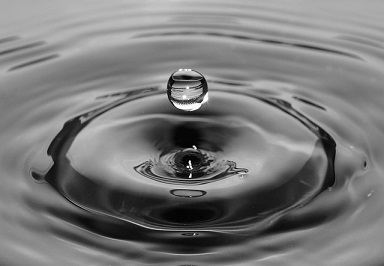
In order to properly clean the water in your turtle tank, you’re going to need a canister filter that can move a lot of water. In most cases, you will need to get a canister filter that has nearly double the flow rate you would need if you were just keeping fish in an aquarium.
A good rule of thumb to follow is that your filter should turn over the water in your tank at least 4 to 6 times an hour. If you have a particularly messy turtle you might want to get a filter that turns the water over 8 times an hour just to be safe.
For example, if you have a 55 gallon tank you are going to need a canister filter with a flow rate of 220 to 440 GPH (gallons per hour). In most cases you can really never have too much water flow, so you should always try to get the most powerful filter that you can fit within your home and your budget.
Mechanical Filtration
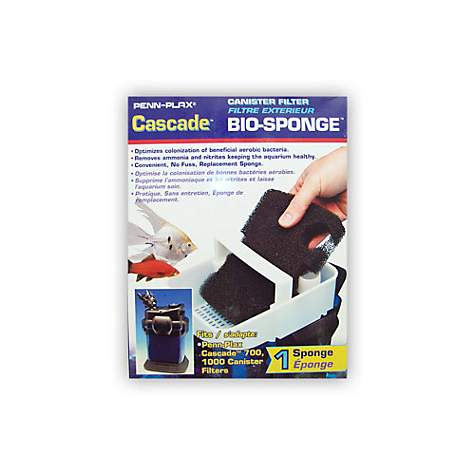
Turtles are well known for being especially messy eaters. All those uneaten food particles need to be removed from the tank before they start to rot and foul up the water. That’s why you need a canister filter with mechanical filtration media that is easy to maintain since you will be cleaning it often.
Try to avoid any mechanical filtration media that is not reusable. This includes floss filtration media and all-in-one filter cartridges. Instead, you should always get a canister filter that uses sponges for mechanical filtration. Sponges are much more effective than floss, and they have larger pores so they are less prone to clogging.
Sponge filters are also reusable, which means you won’t have to spend a lot of money constantly replacing them. All you will need to do is rinse them off in dechlorinated water and then put them back in the canister filter. You might want to keep a spare sponge filter on hand though since they still can clog up, and they will eventually degrade over time.
Chemical Filtration
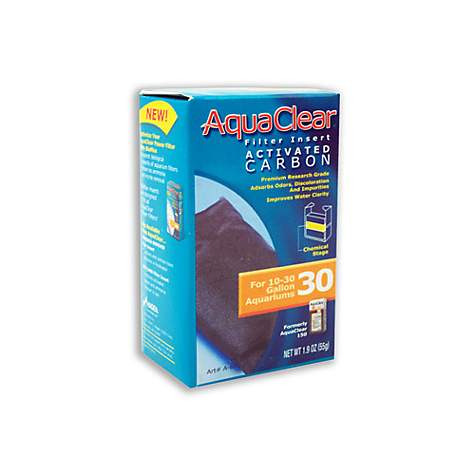
Turtle tanks are notorious for emitting foul odors. This is mainly due to the amount of organic compounds in the water. These organic compounds come from rotting food, and turtle excrement.
In order to remove these volatile organic compounds, you need to use some kind of chemical filtration media. The most common form of chemical filtration is activated carbon. This type of carbon has been specially heat treated to increase its surface area, which allows it to absorb a large amount of dissolved organic compounds.
Most good canister filters will come with some activated carbon as part of the package. You will need to buy more though since activated carbon is not reusable. Once the carbon becomes exhausted you will need to replace it immediately since it will lose its effectiveness.
You also will go through more carbon filtration media in a turtle tank since turtles produce a lot of organic waste. If you notice an increase in odor around your turtle tank that is usually a good sign that it’s time to change the carbon filter. Just be sure to always have some extra activated carbon on hand, so you won’t have to be constantly running out to the store to keep up with it.
Biological Filtration
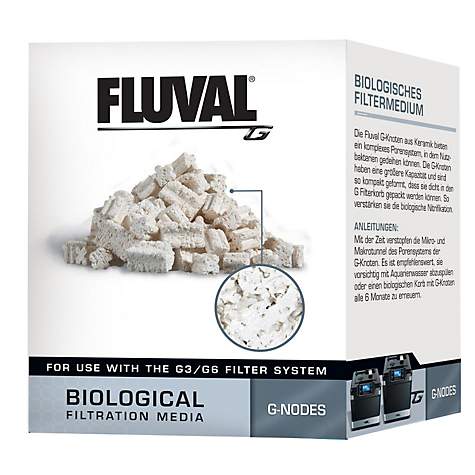
Even though turtles can handle ammonia better than fish, you still need a way to remove this toxic compound from the water. The primary way to deal with this is by providing adequate biological filtration.
Biological filtration media acts as a place for nitrifying bacteria to take up residence and break down ammonia and nitrites into less harmful nitrate. Some common biological filtration media include Bio-Balls, ceramic bio-media, and rock-based media just to name of few of the most popular options.
The primary thing you want to look for in a good bio-media is how much surface area it has for a given volume. Ceramic bio-media tends to have the most surface area along with rock-based matrix. Bio-Balls, on the other hand, tend to have less surface area and are usually better suited for wet-dry filters.
For the most part, as long as you use a bio-media with sufficient surface area then there will be enough space for the nitrifying bacteria to colonize. The biological filter media shouldn’t need to be cleaned often, and in most cases, you want to disturb the bacteria population as little as possible. The only thing you might need to do to maintain the bio-filter is remove any built up detritus, which will help prevent any clogs from forming in your filter.

